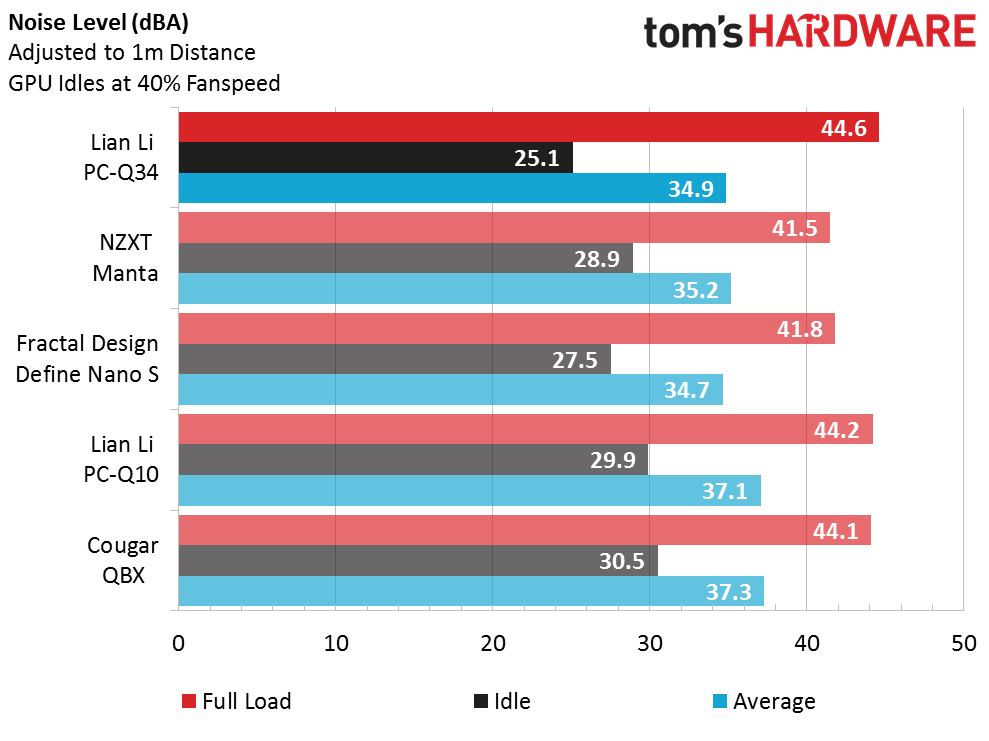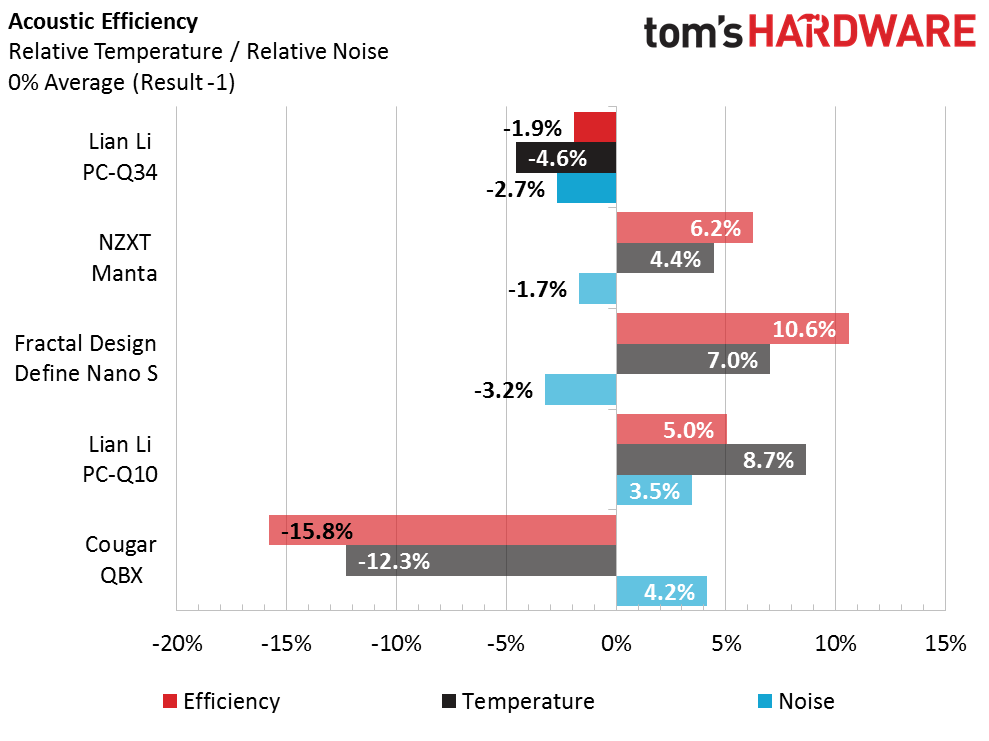Lian Li PC-Q34 Mini ITX Case Review
Known for simplicity and minimalist style, Lian Li looks to shake things up a bit with its latest Q-series iteration, the PC-Q34, which is designed for silence, with a flip top for ease of access. We put the Mini ITX case through its paces.
Why you can trust Tom's Hardware
Test Results And Conclusion
Today’s review uses the same Mini ITX reference platform as past reviews, with no changes to the standard hardware.
Test System Components
| Test System Configuration | |
|---|---|
| Sound | Integrated HD Audio |
| Network | Integrated Gigabit Networking |
| Software | |
| Graphics | Nvidia GeForce 353.30 |
| Chipset | Intel INF 10.0.27 |
We measure noise .5m from the case's front corner, on the side that opens. The numbers are corrected to the 1m industry standard—used by many loudspeaker and fan manufacturers—by subtracting six decibels.
| Benchmark Configuration | |
|---|---|
| Prime95 v27.9 | 64-bit executable, Small FFTs, 4 threads |
| 3DMark 11 | Version: 1.0.3.0, Extreme Preset: Graphics Test 1, Looped |
| Real Temp 3.40 | Average of maximum core readings at full CPU load |
| Galaxy CM-140 SPL Meter | Tested at 1/2 m, corrected to 1 m (-6 dB), dBA weighting |
Additionally, the test duration for today’s review was two hours at full load, and the ambient air temperature for the test was maintained at approximately 26°C (78.8°F).
Comparison Cases
Although the PC-Q34 is designed to be a cool and silent case by way of its fan-optional design, that very same design was intended for use with larger, tower-style coolers, which draw cool air in from the sides and then force it out the rear. However, our Mini ITX test platform uses a down draft style cooler which pulls air in from above and forces it down across the motherboard. While this design is usually more compact and helps cool the motherboard, it most often requires something else to circulate cool air through the case in order to achieve optimum performance.
Test Results
Although it’s not the hottest running case we’ve tested, it does lead most of the comparison cases by a pretty wide margin. It seems that with our particular configuration, the PC-Q34 experiences a large buildup of heat from both a CPU/GPU cooler dumping hot air back into the case and nothing else to help push it out. The good news is that this is likely the worst case scenario for this case, and those numbers ought to see quite an improvement with the use of a better suited CPU cooler or an exhaust fan.
Without an extra fan to make noise at idle speeds, the PC-Q34 is the quietest case in the list at idle speeds, even managing to push the lower limits of our sound meter. However, its vented side panels do little to stop the noise at full fan speed, which also makes it one of the loudest cases in our list.
Get Tom's Hardware's best news and in-depth reviews, straight to your inbox.
All of that extra heat and noise really puts a dent in the PC-Q34’s efficiency, but where does that leave us in terms of value?
The $80 base MSRP of the PC-Q34 allows it to regain some ground in our value figures, only being outdone by two other cases with significantly lower price tags. Note: Even though the base configuration isn’t available yet in the United States, we elected to use its price in our value calculations since it falls in line with the other cases we’ve tested, and would otherwise distort the comparisons.
The PC-Q34 faired pretty well for a no-frills case with no fans and a poor cooling configuration, and still performed well enough to earn our seal of approval.
MORE: Best Cases
MORE: All Case Content
MORE: In Pictures: 40 Unusual Computer Case Mods
Follow us on Facebook, Google+, RSS, Twitter and YouTube.
-
CPU goes 68.3°C OVER ambient? That's not good, not good at all. The Tcase of this chip is 72.7°C.Reply
-
InvalidError Reply
Intel chips have no means of measuring Tcase directly. Those numbers must be Tcore which tops out around 100°C for Intel chips.18688200 said:CPU goes 68.3°C OVER ambient? That's not good, not good at all. The Tcase of this chip is 72.7°C.
-
Nick_50 I think they just went for the wrong CPU cooler. There is space for a 180mm tall cooler which means you can use something pretty decent. My mini itx build only has 140mm space and it goes to 50C max temp with fans on two thirds speed. I realise this case doesn't have a front intake but 68C over an ambient temp of 26C is 94C. I wouldn't want to be running my system anywhere near that temp personally.Reply -
synphul Kind of an interesting case. The price isn't too terrible for the standalone case option. Wish they would have maybe gone just a little further with the case design and added properly spaced fan attachment points on the side openings so someone could add an intake if they wanted.Reply
Also the space next to the psu which appears to be a vertical drive rack, there's only one. There was plenty of room to add another along side without hitting the front of the case so a bit of wasted space.
I like the look of it though and the way it hinges open it could almost double as a test rig for smaller platforms. -
gadgety What does the PC-Q34 bring, apart from styling changes, and atm pretty bad product bundling, that the PC-Q33 didn't have?Reply -
Reply18688250 said:
Intel chips have no means of measuring Tcase directly. Those numbers must be Tcore which tops out around 100°C for Intel chips.18688200 said:CPU goes 68.3°C OVER ambient? That's not good, not good at all. The Tcase of this chip is 72.7°C.
My data comes from ark.intel.com , which shows Tcase for this processor.
-
InvalidError Reply
It does not matter where you pulled Tcase from, my point is that the only way to measure it is to drill a hole through the heatsink and attach a thermocouple there - that's Intel's official Tcase measurement method in its thermal design specifications.18689106 said:My data comes from ark.intel.com , which shows Tcase for this processor.
Junction temperatures are higher than case temperature due to the junction-case thermal resistance and the digital temperature sensing circuits being built directly in the cores where most of the power gets turned into heat. -
Stevemeister Given the case was not used with the type of cooler it was designed to operate with it, for the sake of an extra 60 minutes testing it would have been interested to see how much difference it would have made to the operating temperatures if a rear fan had been installed.Reply -
2Be_or_Not2Be If the height & design of the case seems to indicate a tower cooler would the intended use case, why not also test it w/a tower cooler in addition to the downdraft one used?Reply
I like the "worst case" scenario, but I would also have liked to see how it performed with a tower as it was seemingly intended. -
superflykicks03 Why test only the "worst case scenario"? For standardization purposes when comparing performance to other cases I understand. But this review does not tell the reader anything about the potential of the case and whether or not it would be a good solution if utilized in an optimal way. The methodology does not allow the reader to come to an informed purchasing decision.Reply






